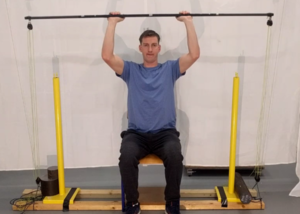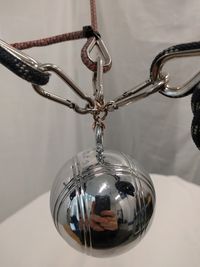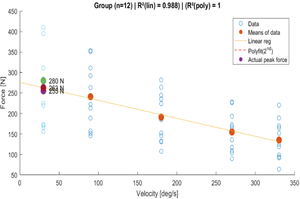Lars Claes F2017
Two individual master thesis' were made in unofficial collaboration by Lars K. Feddersen(Robotics student) & Claes C. Jakobsen(Welfare Tech student) in E16 and F17.
Contents
Collaboration
The first goal of the project was to test out use cases for the RoboTrainer, to see whether they were possible/practical and to eventually choose one case and make a proof-of-concept model.
The use cases were divided into four categories:
- Free weights simulation
- Simulated gravity (under water)
- Gait training
- Machine training evaluation
Free weight training simulation
By using two RoboTrainers, free weight barbell training can be simulated.
Advantages:
- Measure force, position, speed and acceleration.
- Dynamic loading in a wealth of ways
- Simulate gravity
- Pure eccentric, concentric or isometric training.
- Flywheel simulation
- Safety
Lars' individual project
Abstract:
This master thesis is an analysis aimed at exploring the functionality of the RoboTrainer Light (RTL) in other fields of training than its original intension. During the thesis four experimental setups are developed that involved body weight supported gait, free weight training, weightless strength training and rehabilitation training in three dimension. These setups were accomplished by extending the functionality of the RTL in the form of hardware and software. A new control software for the RTL was developed, using ROS (Robot Operating System), that allows for a modular design with the possibility of synchronizing the control of multiple RTLs.
The four experimental setups show that RTL can be, by simple means, altered to target other training fields, using the new control software. The RTL force control system works well for producing artificial gravity, natural body weight support and weight plate simulation. However, the maximal torque and velocity produced by the RTL was deemed too low when used for strength training. Functional training in three dimension was successfully accomplished by deriving the inverse kinematic and developing a calibration procedure. Assisted force control and trajectory following was also successfully implemented, allowing for performing a range of different rehabilitation exercises.
Claes' individual project: "New Applications for RoboTrainer Light"
Abstract:
This report is divided into two parts. The first part studies the feasibility of using the Robo-Trainer Light for new exercise purposes; free weights training, gait assistance and simulating gravity. The results of these experiments indicate that these are definitely possible to create, but there is also room for improvement as a more powerful motor is needed for an optimal experience. The second part is an exploration of a novel method of predicting strength for load assignment using the force-velocity relationship using both the RoboTrainer Light and Classic. Correlations were very high (r 2 = 0.88 and 0.99) but different (± 12.6% and ± 22.4% of actual peak force). These results fall right in line with results from studies using similar methods (submax testing: ± 14% to ± 21% of actual 1RM) making it an interesting method to further explore.
Link to Claes' master thesis report: https://www.dropbox.com/s/byuav62ae1tjrq7/Claes%20Speciale.pdf?dl=0


